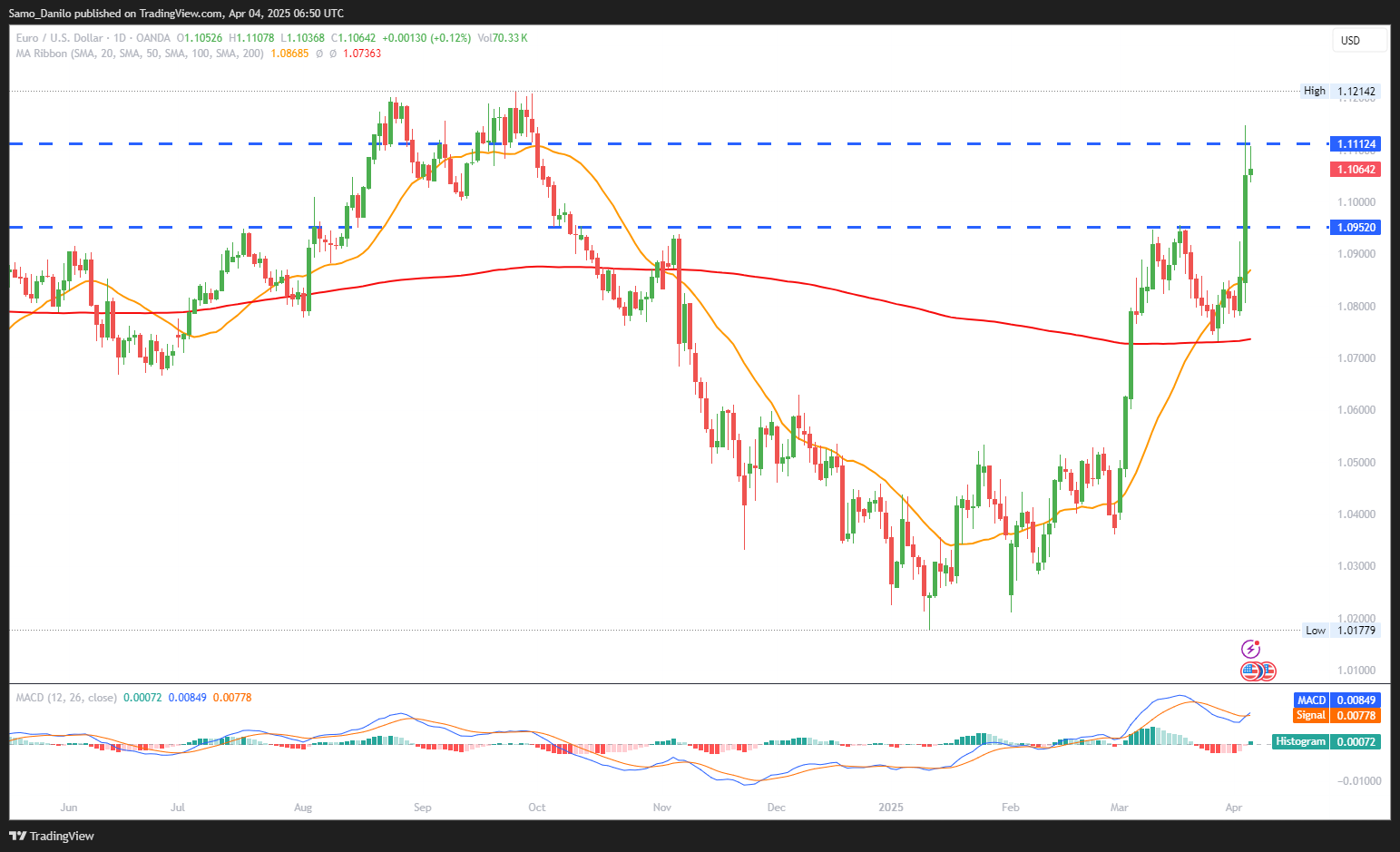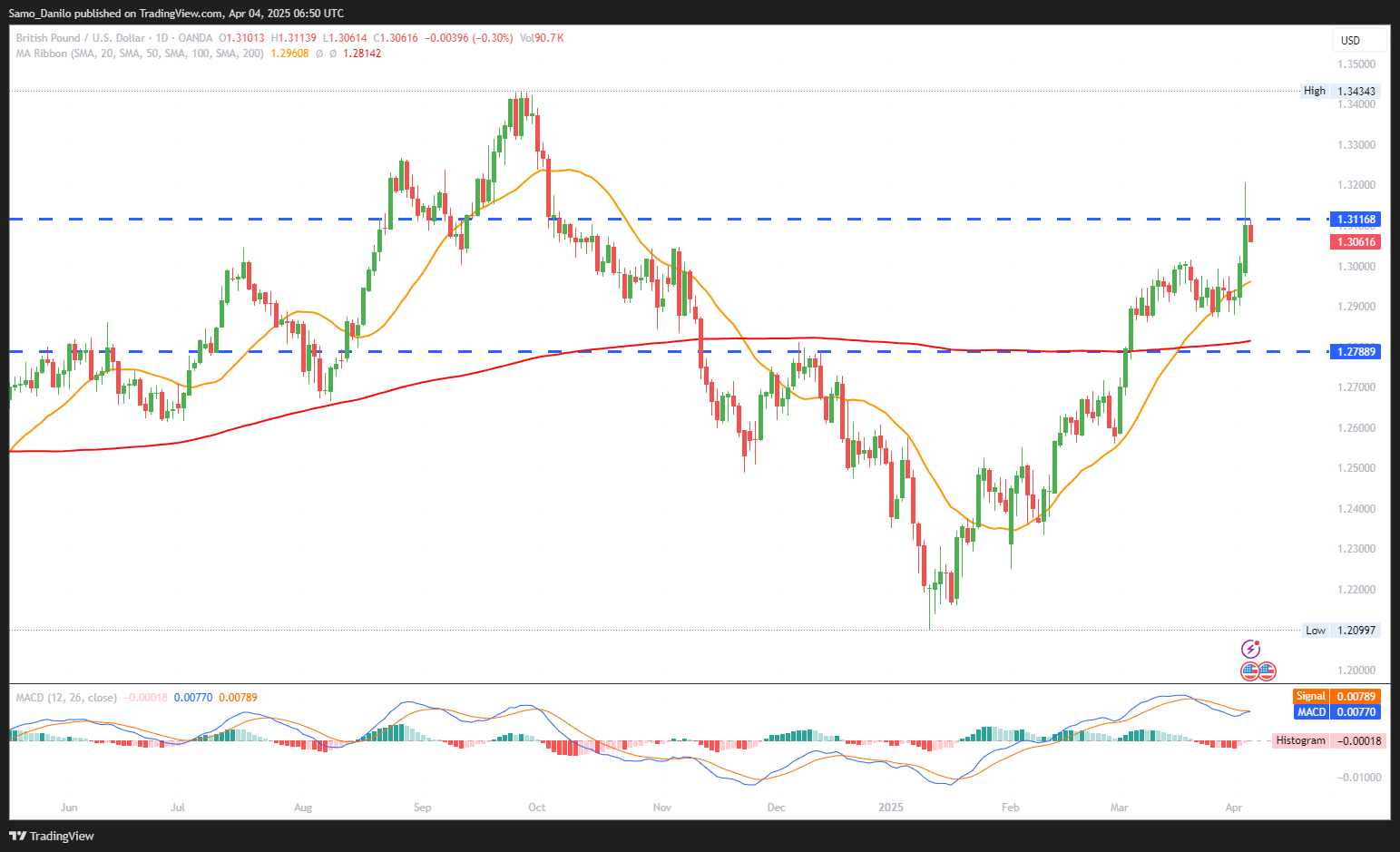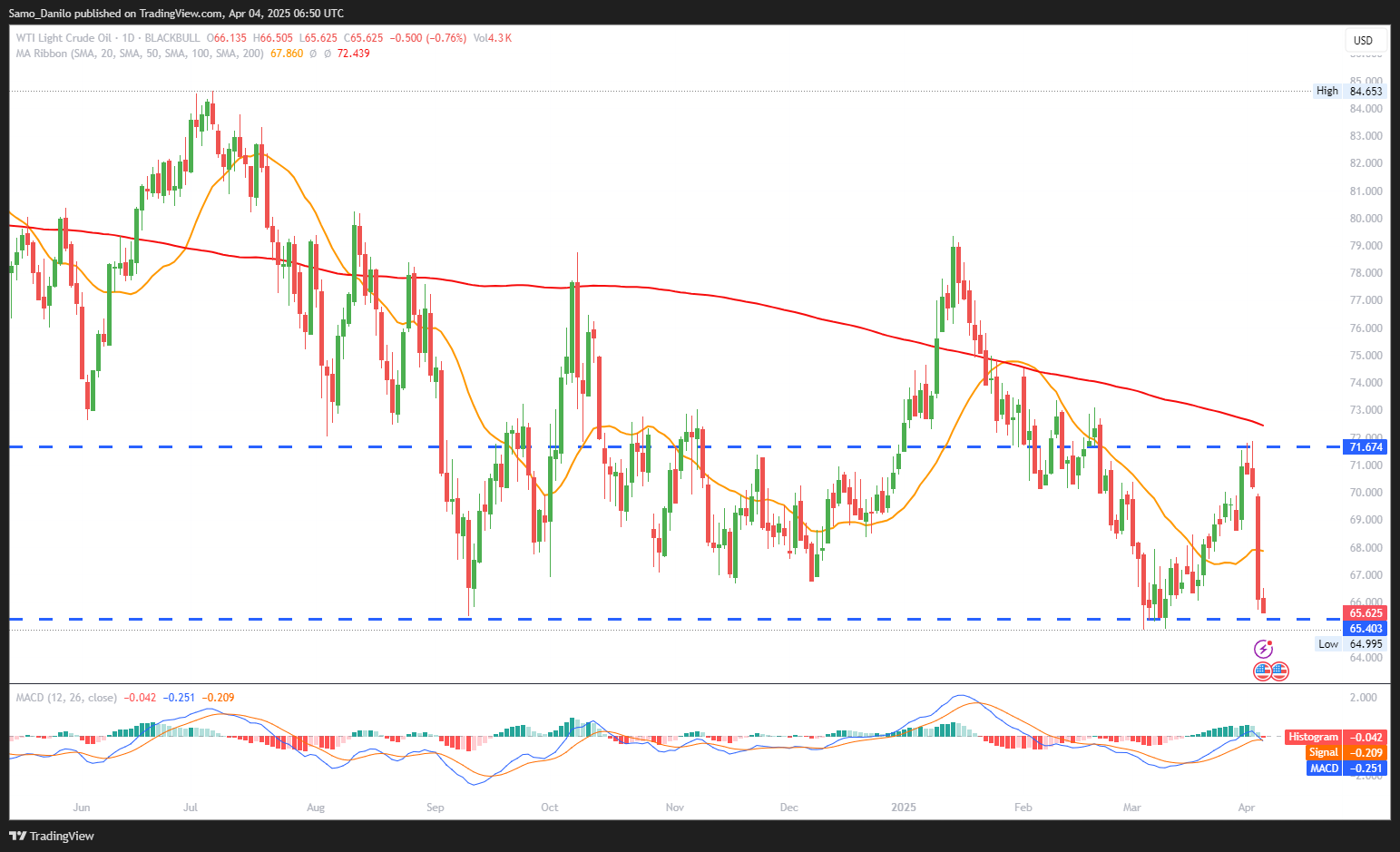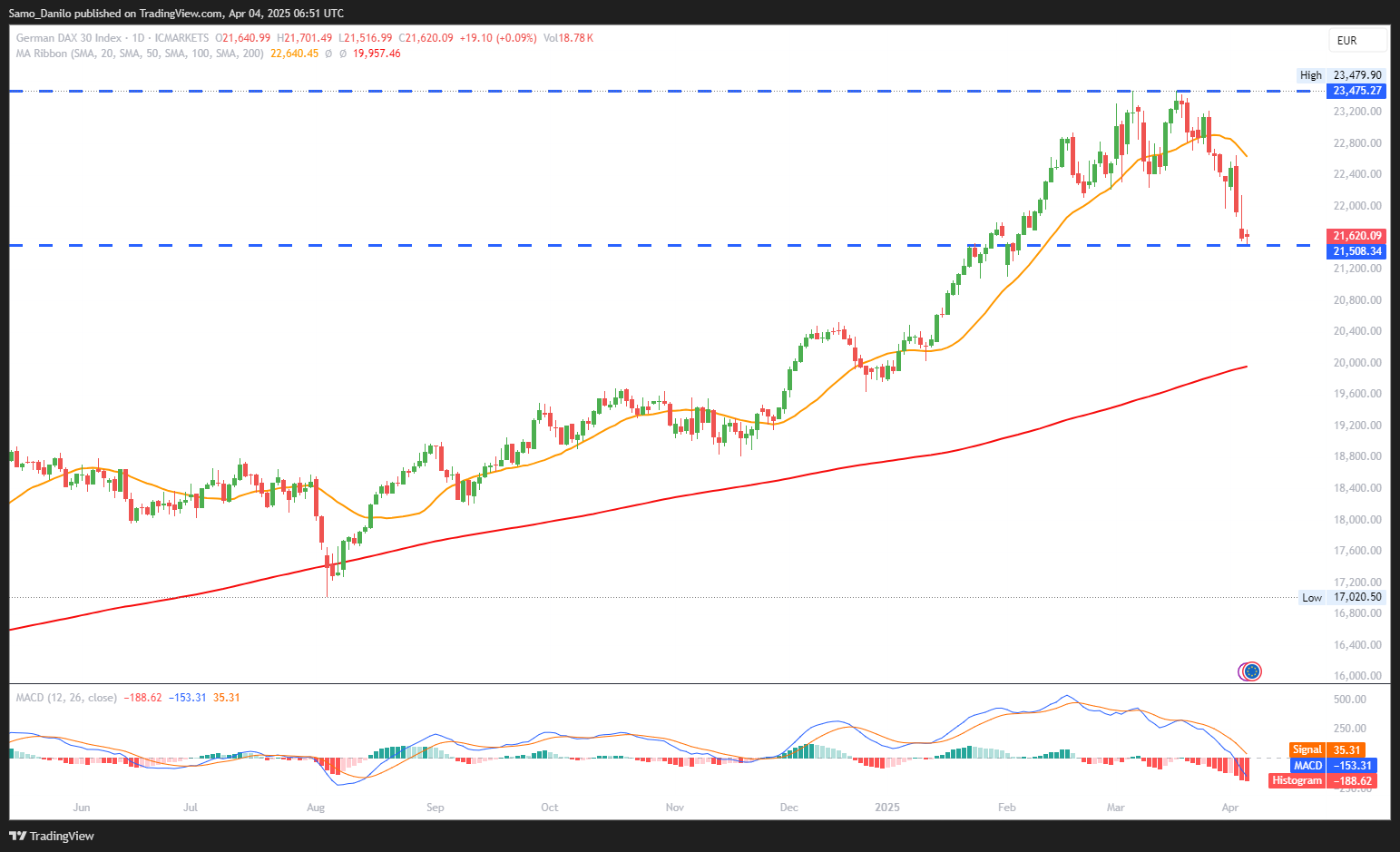EURUSD
- EUR/USD Price: The EUR/USD pair remains stable near 1.1100 in early European trading. Immediate upside is capped at 1.1145, with further resistance at 1.1200 and the 2024 high of 1.1213.
- Global Tariffs: President Trump introduced a 10% baseline tariff on most imports, including a 20% levy on EU goods. The move raises trade tensions and weighs on market sentiment.
- US ISM Services PMI: Investor confidence took a hit after the US ISM Services PMI fell to 50.8, marking a nine-month low and one of the sharpest monthly declines since the pandemic.
- ECB Rate Cut: Money markets now price in an 80% chance of a 25 bps ECB rate cut in April, as weaker US data and trade concerns bolster expectations for monetary easing.
- US Data Events: Traders now turn to Friday’s Nonfarm Payrolls (NFP) report and Fed Chair Powell’s speech for fresh guidance on US monetary policy.
Closing statement: While EUR/USD remains resilient, trade tensions and weakening US data keep investors cautious, with all eyes on NFP and Powell’s remarks for further market direction.
GBPUSD
- GBP/USD Price: The GBP/USD pair remains supported below 1.3100 in early European trading, as persistent US Dollar weakness due to recession fears and dovish Fed expectations underpins the pair.
- US Markets Selloff: US equities suffered their biggest one-day percentage drop since 2020, following Trump’s announcement of global tariffs set to take effect on April 9.
- UK Tariff Stance: While other governments are either imposing counter-tariffs or adopting a wait-and-see approach, the UK, which faces a relatively mild 10% tariff, is holding back—though it has prepared a list of US goods for potential retaliatory measures.
- UK Business Minister: Business Minister Jonathan Reynolds ruled out any fiscal policy adjustments in response to tariffs, stating that the UK should not escalate the trade dispute further.
- Fitch Warning: Fitch Ratings cautioned that Trump's tariffs could influence the Federal Reserve, potentially delaying interest rate cuts as the Fed monitors inflation and employment effects.
Closing statement: Despite lingering USD weakness, trade uncertainty and the Fed’s policy outlook remain key drivers for GBP/USD, with investors closely watching tariff developments and potential retaliatory measures.
XAUUSD
- XAU/USD Price: Gold prices slipped on Friday, encountering fresh supply, but downside potential remains limited as XAU/USD continues to trade above the $3,100 per ounce level.
- JP Morgan Warning: Analysts at JP Morgan cautioned that Trump’s tariffs, if sustained, could push the US—and potentially the global economy—into a recession this year, adding to market uncertainty.
- Fed's Officials: Fed Governor Lisa Cook and Vice Chair Philip Jefferson were among the latest policymakers to warn that tariffs could increase inflation risks, potentially delaying expected Fed rate cuts.
- US Employment Data: Investor focus now shifts to US Nonfarm Payrolls (NFP) data, scheduled for release later on Friday, which could impact rate expectations and influence gold’s next move.
- Powell’s Speech: Fed Chair Jerome Powell is set to speak later today, providing further insights into the central bank’s stance on monetary policy and the economic impact of tariffs.
Closing statement: Gold remains supported above $3,100, with Fed rate cut expectations and recession fears underpinning demand. However, US jobs data and Powell’s remarks will be key catalysts for gold’s next direction.
CRUDE OIL
- Crude Oil Price: West Texas Intermediate (WTI) crude oil prices remain under pressure for the fourth consecutive session on Friday, sliding to $66.20 per barrel amid persistent bearish sentiment.
- OPEC+ Output Increase: Eight OPEC+ members moved forward with their plan to phase out production cuts, announcing a combined output increase of 411,000 barrels per day in May, adding to supply concerns.
- US Crude Inventories: The EIA's weekly report revealed a 6.17 million-barrel increase in US crude stockpiles, further weighing on oil prices and signaling weaker demand.
- US Dollar Weakness: The US Dollar remains near its lowest level since October, as investors bet that economic headwinds from tariffs could force the Federal Reserve to resume rate cuts.
- US Jobs Data: The US Nonfarm Payrolls (NFP) report, due later Friday, is expected to show 135K new jobs added in March, with the Unemployment Rate projected to hold at 4.1%, potentially influencing oil demand expectations.
Closing statement: WTI remains under selling pressure, driven by rising supply from OPEC+ and growing US crude inventories. The US jobs report and Fed rate outlook will be key in shaping oil’s next move.
DAX
- DAX Price: German equities took a major hit on Thursday following US President Donald Trump's tariff announcements, as investors weighed the economic risks of escalating trade tensions.
- Technical Indicators: After Thursday’s sharp decline, the DAX remains below the 50-day EMA, signaling near-term downside risks, but still holds above the 200-day EMA, which provides longer-term support.
- Macron's Reaction: French President Emmanuel Macron urged European firms to suspend US investments, while Germany’s economy minister called for a strong EU response to Trump’s trade measures.
- German Factory Orders: Official data from the Federal Statistics Office showed 0% growth in factory orders for February, indicating continued weakness in Germany’s manufacturing sector, following January’s 5.5% decline.
- US Jobs Data: While tariff developments remain the key market driver, Friday’s US Jobs Report and Fed Chair Powell’s speech could influence global sentiment, impacting the DAX’s near-term trajectory.
Closing statement: The DAX remains vulnerable to further downside, with weak economic data and escalating trade tensions weighing on sentiment. Investors should closely monitor US labor data and Fed commentary for potential market direction.




